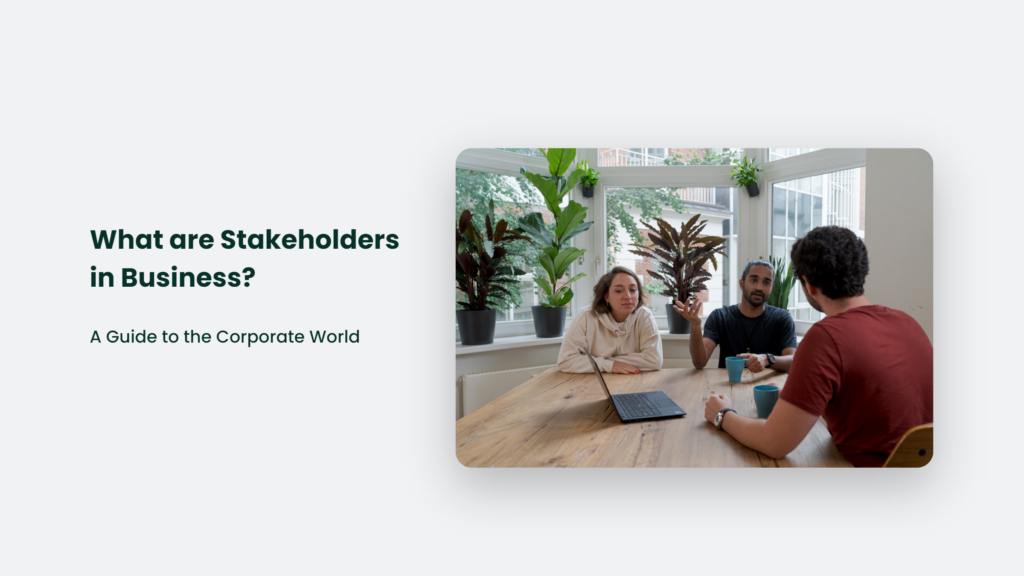Ah, stakeholders. The bane of every middle manager’s existence. These needy, whiny, sad sacks are always clamouring for more attention, resources, and absurd demands.
As if the job wasn’t hard enough already.
Well, friends, we’ll rip the bandaid off today and tell it like it is. What exactly is a stakeholder? Why do they matter? And how can you placate these jokers without losing your mind? Grab some popcorn and buckle up because we’re going on a wild ride through the corporate jungle.

What are Stakeholders in Business?
A stakeholder is essentially anyone who has a “stake” or interest in your company. It includes:
- Investors: The moneybags who provide the capital to start or grow your business. All they care about is seeing returns.
- Employees: The people who actually do the work. They want job security, good benefits, and not to be treated like dirt.
- Customers: The folks who buy your products/services. They want quality, value, and good service.
- Suppliers: The companies that provide your business materials, components, or services. They want prompt payment and future orders.
- The community: Groups or individuals who are impacted by your operations. They want you to minimize harm.
- The government: Local, state, and federal agencies that regulate businesses. They want taxes paid, and laws followed.
Basically, if someone is impacted by what your company does, they’re a stakeholder. And that means you have to keep them happy. Let’s look at some examples:
Got a new investor who poured millions into your startup? Well, buckle up, buttercup, because now they’ll be breathing down your neck, demanding to see skyrocketing growth and a fat IPO payday.
Hired a new supplier to provide parts for your manufacturing plant? You better pay their invoices on time to keep that relationship smooth.
Expanding into a new neighbourhood? The local residents will be on the lookout for any disruptions you might cause.
See how this works? Stakeholders all have their own interests and objectives regarding your company. If you want to succeed, you need to find ways to satisfy them (at least enough to keep them off your back).
Why Should You Care About Stakeholders?
Look, I get it. Stakeholders can seem like a giant pain in the behind. All they do is make demands, complain, and get in the way of you doing your job, right?
Wrong. The truth is that keeping your stakeholders happy is critically important for any company. Here’s why:
They provide the resources you need to operate.
Investors supply capital, employees provide labour, and suppliers provide materials and services. No stakeholders = no business.
They use leverage to protect their interests.
Unhappy stakeholders can inflict major damage, from lawsuits to strikes to regulatory crackdowns. You don’t want to poke a bear.
Satisfying them builds goodwill and loyalty. Make stakeholders feel valued, and they’ll reward you with continued support. That’s invaluable.
It’s just the right thing to do. Come on, have a heart. Most stakeholders just want to be treated fairly while you focus on profits. Don’t be a jerk.
So, in a nutshell, keeping your stakeholders satisfied helps ensure your company has the resources, environment, and relationships needed to be successful. It’s a win-win.
Plus, building trust and goodwill with stakeholders can provide all sorts of benefits:
- Employees are more engaged and productive
- Customers are more loyal and become brand advocates
- Investors eagerly fund your growth plans
- Suppliers are reliable partners, even in tough times
When you treat stakeholders right, it creates an ecosystem where everyone thrives together. Now, doesn’t that sound nicer than constant conflicts?
The Most Common Stakeholders and What They Want
Alright, enough hippie talk. Let’s get down to brass tacks and look at some specific stakeholders you’ll encounter and what they expect from you:
Investors
What they want: Profits, growth, returns on investment.
How to satisfy them: Generate strong financial results, communicate progress regularly, and be transparent.
What happens if they’re unhappy: They sell their shares, stop funding growth, and oust management.
Investors don’t invest out of the kindness of their hearts – they expect to make money. Give them consistent returns and growth, and you’ll have no problem satisfying them. Start underperforming, though, and you better watch out.
Employees
What they want: Fair pay, good benefits, safe working conditions, opportunities for advancement.
How to satisfy them: Offer competitive compensation and benefits, cultivate an inclusive culture, and provide development opportunities.
What happens if they’re unhappy: Low morale, high turnover, lawsuits, strikes.
Employees are the lifeblood of any company. Take care of them with fair treatment and competitive rewards, and they’ll repay you with loyalty, hard work, and low turnover. Mistreat them, and you can expect major headaches.
Customers
What they want: Quality products/services, fair prices, good customer service.
How to satisfy them: Deliver consistent value and quality, be responsive to feedback, and offer loyalty incentives.
What happens if they’re unhappy: Loss of business, negative brand perception, lawsuits.
Your customers pay the bills, so keeping them happy needs to be priority #1. Give them great products, listen to feedback, fix problems promptly, and provide incentives for loyalty. Do that, and they’ll sing your praises far and wide.
Suppliers
What they want: Timely payments, long-term partnerships, large orders.
How to satisfy them: Pay on time always, sign long-term contracts when possible, and give adequate notice for big orders.
What happens if they’re unhappy: Refusal to deliver, legal action, loss of partnership.
You depend on suppliers to provide materials and services crucial to your own operations. Make sure you always pay on time, forecast your needs properly, and try to nurture long-term relationships. It ensures a reliable supply chain.
The Community
What they want: Social responsibility, minimal harm/disruption, philanthropy.
How to satisfy them: Be a good corporate citizen through charity, volunteer work, and local partnerships. Minimize negative impacts.
What happens if they’re unhappy: Protests, legal action, reputational damage.
The community where you operate can make or break your reputation. Be a good corporate citizen through charity work, volunteer programs, and local partnerships. Minimize any negative impacts from your operations. You will likely gain their support if the community sees you as a partner. But if you’re a poor neighbour, they can inflict PR nightmares.
Government Regulators
What they want: Compliance, taxes, transparency.
How to satisfy them: Follow regulations, pay taxes on time, and be honest.
What happens if they’re unhappy: Fines, shutdowns, lawsuits, criminal charges.
You must comply with relevant regulations and pay your taxes. Don’t try to cut corners or mislead officials. Building trust and goodwill with regulators makes them more likely to be cooperative partners. Attempting to cheat or deceive them is asking for a world of hurt.
Activist Groups
What they want: Advance their particular cause, force change.
How to satisfy them: Be responsive to their concerns and make concessions when feasible.
What happens if they’re unhappy: Protests, boycotts, reputational damage.
Activist groups like environmentalists, human rights advocates, or consumer watchdogs can sometimes impact your operations. Understand their concerns and make reasonable efforts to address them. Total capitulation isn’t necessary, but some compromise can prevent headaches.
Key Takeaways for Dealing with Stakeholders
Managing diverse stakeholders with competing interests is tricky but vitally important. Here are some key tips:
- Identify all your key stakeholders and understand their goals. What do they want from you?
- Prioritize keeping investors, customers, and employees satisfied. Their support is most critical.
- Communicate often and transparently with stakeholders. Make sure they’re informed.
- Try to balance stakeholder needs instead of maximizing value for only one group.
- Build relationships and trust with stakeholders over time. It provides goodwill in hard times.
- Compromise when necessary to maintain stakeholder support. Don’t be rigid.
- Develop processes for gathering stakeholder feedback. It allows you to monitor their sentiment.
- Have a crisis management plan to handle worst-case scenarios like lawsuits or protests.
The more you can proactively engage with stakeholders, address their concerns, and manage expectations, the less likely you’ll face big shocks or conflicts. It’s just savvy business.
So, while stakeholders can seem annoying at times, the reality is you need their support to succeed as a company. Treat them respectfully, communicate effectively, and find win-win solutions whenever possible. Do that, and you can keep the corporate circus running smoothly.
Frequently Asked Questions:
What if stakeholders want conflicting things?
Compromise and make trade-offs. Maximize total value across groups as much as possible.
How many stakeholders should I focus on satisfying?
Prioritize your core stakeholders – investors, employees, and customers. But try to keep all groups reasonably satisfied.
Conclusion:
Well, that about wraps it up! Hopefully, this take-no-prisoners guide has armed you with the knowledge needed to tame the corporate zoo. Just remember: stakeholders hold more power than you think. Keep them satisfied, and your business will reap the rewards. Let me know if you have any other burning questions!




